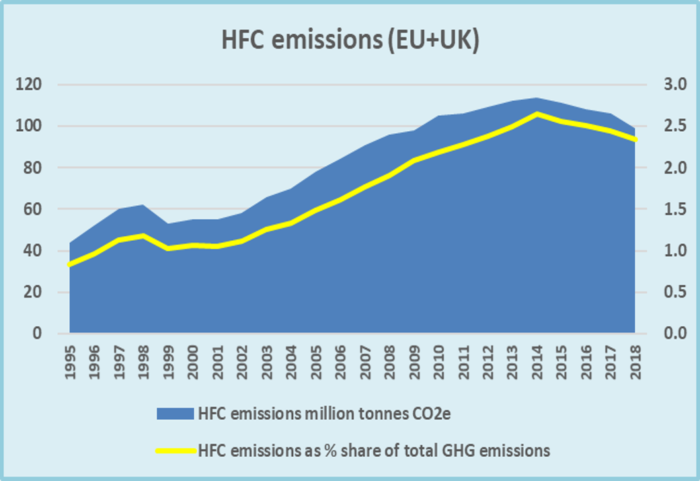EU REPORTS DECREASING HFC EMISSIONS FOR FOURTH YEAR
The EU publishes annually its official inventory of greenhouse gas emissions as required under the UNFCCC. For the 4 years since 2014, reported HFC emissions have decreased each year and, also decreased as a percentage of total EU emissions. “In particular, it is worth highlighting that HFC emissions from refrigeration and air conditioning have decreased for the fourth consecutive year since 2014.” RAC emissions in 2018 decreased by 7% compared to 2017. “Moreover, refrigeration and air conditioning sectors have also grown to some extent in Europe in the last decades.” Reported 2018 total emissions of HFCs also decreased by about 7% compared to 2017.
There is increasing adoption of lower GWP HFCs, HFC/HFO blends and ultra-low HFO/HCFOs contributing to reduced HFC emissions. According the EEA Fluorinated greenhouse gases 2019 report, in 2018 HFOs/HCFOs accounted for about 20% of the reported total sales in metric tonnes of total HFCs, HFOs and HCFOs (see EFCTC March 2020 newsletter article ‘Average GWP continues to fall as HFOs and HFC-32 consumption increases in 2018’).
The EU F-gas Regulation 517/2014 sets out several measures to reduce use and emissions of F-gases with a focus on HFCs, resulting in the trend of reductions in reported HFC emissions for 4 years and a decreasing percentage of total EU greenhouse gas (GHG) emissions, even though total GHG emissions are also reducing. In the same 4 years period total GHG emissions have decreased by about 2%, compared to HFC emissions reduction of about 13%. The chart shows HFC emissions and as a percentage of total GHG emissions.

Refrigeration and Air Conditioning is by far the largest sub-category accounting for 89% (EU-27+UK) of HFC emissions for the category product uses as substitutes for ODS. The chart shows the contribution of the various sectors to HFC emissions.

Note that the categories solvents and other applications are extremely small percentages of the total
Explanatory Note: The data used in this article is for EU+UK. The HFC emissions is shown as a percentage of total EU+UK emissions, which excludes emissions due to LULUCF (land use, land-use change, and forestry).
Effect of illegal trade– the June 2020 EFCTC press release on illegal trade imports indicates that this illegal trade could represent up to 34 million tonnes CO2 equivalent – or 33% of the legally allowed quota in 2018. While completely unacceptable that this level of illegal trade has occurred, the large phase-down step in 2018 means that the HFCs estimated to have been supplied in the EU is significantly lower than 2017 (estimated 135 million tonnes CO2e in 2018 compared to a the HFC cap of about 170 million tonnes CO2e in 2017), and together with measures to minimise emissions is consistent with a reduction in HFC emissions. However, unless illegal trade is effectively eliminated emission reduction trends may not be sustained.
Reference: The EEA Annual European Union greenhouse gas inventory 1990–2018 and inventory report 2020. Submission under the United Nations Framework Convention on Climate Change and the Kyoto Protocol 27 May 2020 see official inventory of greenhouse gas emissions.